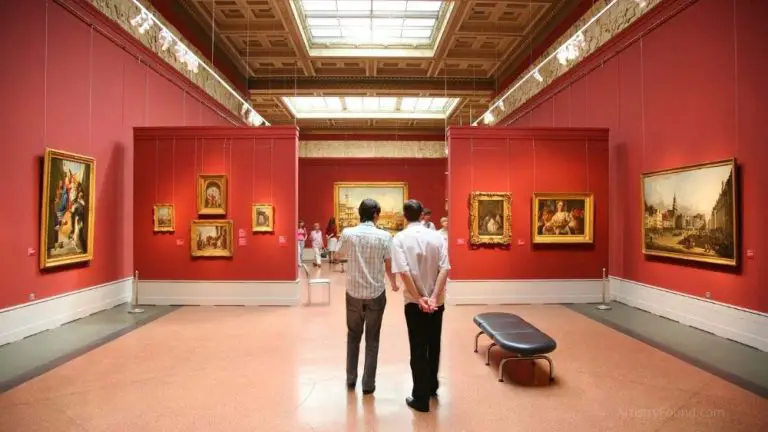How to Visit an Art Museum The Right Way (15 Top Tips!)
When visiting a new city, there’s a good chance there are at least one or two art museums on the “must-visit” list for any art-loving tourist.
But if you aren’t familiar with art or the common behaviors people exhibit in an art museum, you might feel a bit like a fish out of water.
When visiting an art museum, make sure you plan ahead and know the etiquette. Wear comfortable clothes, and utilize the guide programs and lectures to help orient yourself to the museum’s offerings. Go slow and take your time. When you need a break, make use of the museum’s cafes and restaurants.
In this article, I’ll dive in and tell you everything you need to know in order to visit and enjoy an art museum in the best way possible.

1. Plan Your Visit Ahead of Time
When thinking about visiting an art museum, it is important to know what you’re getting into.
Does this museum showcase local art or works from the Impressionist masters? Will you be seeing ancient Egyptian artifacts or paintings of Campbell’s soup cans?
The first step to enjoying anything is to not go in blind. Instead, spend an hour or two looking into some of the art online.
Many art museums offer a virtual tour or online catalogs of the art in the museum. Also, look for articles and documentaries about the artist.
The more you know about the subject, the more you can put it into context, and the more likely you are to make a connection with the work.
PRO TIP: Be sure to check the museum’s hours online before you go. Many museums close early — including art museums — so you should plan ahead in order to ensure you have enough time to fully enjoy the art.
2. Know The Museum’s Etiquette
Museum etiquette is not written in stone, but there are a few rules that seasoned museum-goers abide by religiously.
First of all, don’t touch. Most museums offer barriers so guests can know where to stand, but some don’t. So err on the side of caution, and don’t get too close.
It’s also generally understood that you are supposed to speak in hushed tones.
No one likes a museum-goer who interrupts others’ experiences with the art, and loud shouts across the room are no doubt a distraction.
Walk slowly and deliberately, taking in each piece as you come to it, and give others space to take in the art in their own time, without rushing.
3. Wear Comfortable Clothes
When visiting large museums like the Metropolitan Museum of Art or the Louvre, one thing’s for sure: you will be on your feet for hours.
While most museums offer benches for weary tourists and art enthusiasts to sit and take a load off, you need to be prepared.
The last thing you want is for your experience of the art to be dampened due to painful shoes, blisters, and uncomfortable clothes.
Wear something light and bring layers. It can sometimes get cold in the cavernous galleries, especially for those who dress for an afternoon in the summer heat.
4. Find a Museum Guide
It’s always a great experience to have someone passionate about the subject explain the historical context of a particular piece of art.
Many museums have docent programs or a guided tour that can help you understand the art of the era and how it relates to other art that is also housed in the museum.
5. Make Use of The Museum’s Audio Guide
Many museums offer a pre-recorded audio tour for those who want to experience the work solo.
In many ways, this provides the optimal way to view the museum’s art collection. The audio guide will give you more information than you can possibly get by reading in a short amount of time, and it will help drown out any noise or conversations going on around you.
I personally find that an audio tour gives me the most enjoyable museum visit experience, especially when visiting alone.
6. It’s Okay if You Don’t Get The Art
Art is subjective. Sometimes, you’re just not going to get it, and that’s okay. Not all art has to be understood.
In fact, some art is not even meant to be understood! For example, Modern Art is filled with art without meaning.
Rothko and Jackson Pollock’s paintings are nothing more than paint splashed across a canvas, but they are meant to evoke an emotional response in the viewer that is beyond intellectualization.
Step back, forget about knowing anything, and just experience the way the art makes you feel.
7. Don’t Miss Out On The Museum Amenities
Many museums offer cafes and even restaurants for museum-goers. For instance, Tate Modern in London has a wonderful restaurant that offers a break from the art and a chance to eat delicious food.
You can even pick up a print at the gift shop as a memento, especially if a certain piece of art feels important to you.
Art museums, especially public ones, often have a tough time financially, and you can help them out by patronizing their cafes and gift shops while you’re there.
8. Don’t Get Hung up on Taking Photos

(This article may contain affiliate links and I may earn a commission if you make a purchase)
You’ve seen them. A crowd of people standing around the Mona Lisa with their phones in the air, trying to get the best shot for their Instagram page.
But when you’re so focused on getting the perfect picture, you can forget about the experience of actually looking at the art.
While there’s nothing wrong with taking photos, make an effort to put the phone away, and spend some time with your eyes focused on the art that’s in front of you, at least for a little while.
9. Slow Down and Take Your Time
Great. You’ve put your phone away. Now you can take the time to actually look at the art.
Spend some time with each image or sculpture. Then ask yourself: how does this make me feel?
Does it remind me of anything else? Think about what it must have been like to create that piece of art. Put yourself in the artist’s shoes.
Art is about connection and what better way to connect than to let your mind explore what the artist felt?
10. Realize You Won’t See Everything
If you’re heading to a large or even a medium-sized museum, you need to realize early on that you won’t be able to see every piece of art the museum offers.
Instead of racing from one end of the museum to the other, it’s often a better idea to spend time in the areas that interest you most.
It’s better to miss something than to not really see the exhibition, gallery, or painting that is right in front of your face.
11. Visit Regularly For Shorter Time Periods
Museum fatigue is a real thing. No matter how much you’re enjoying yourself, many museums can take hours, days, or even weeks to fully explore.
If you try to cram it all in, you will get exhausted to the point that you won’t really be seeing anything.
If the museum is located near where you live or you make regular visits to the area, try visiting the museum multiple times for shorter time periods.
By just visiting one or two areas of the museum per visit, you will be fresh and alert enough to truly experience the visual art and give it your full focus.
12. Visit The Temporary Exhibitions First
When visiting museums, if at all possible, make sure to visit the temporary exhibitions first.
Most major museums have a rotating traveling collection of artwork that will only be available for a limited amount of time, while the museum’s permanent collection will be on hand for you to visit at a later date if necessary.
13. Bring a Museum Buddy
Art is often best experienced with others, either on a date or with friends.
Ask your museum partners what the art makes them think about. No doubt you will be able to have some interesting discussions that weren’t possible beforehand.
14. Take Advantage of Free Admission Day
Most public art museums have free admission days available throughout the year. These are days where the general admission charge is waived for any museum visitor.
You’ll need to check with the specific museum for dates and times.
15. Attend Lectures
Now that you know the best way to enjoy an art museum, you can continue your education and make each future visit more enjoyable.
Museums often offer lecture series with art historians working in the industry to help you understand the current work museums are doing to preserve history.
Keep up to date with the artists that interest you, and make an effort to attend a lecture.
16. Become a Member of the Museum (Bonus Tip)
By becoming a museum member, you can take advantage of the museum’s art gallery any time it’s convenient for you for a full year.
Also, museum memberships often come with perks such as free guest passes for friends and admission to special events.
This, of course, only works if you live nearby but is well worth it if you love exploring the artwork of your local museum.
Conclusion
I hope these tips for visiting and enjoying an art museum will help you do just that.
As you can see, there are plenty of ways to have fun at an art museum while becoming more educated in the process.
So, go ahead and plan a visit to your local art museum. Who knows? You might develop a passion for art you didn’t even know you had!





